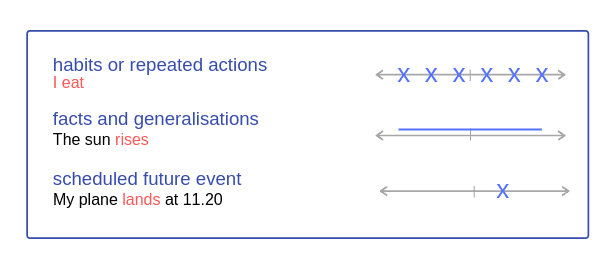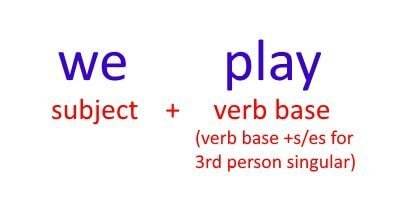Present Simple
timeline, form, uses

The Present Simple is used to talk about habits, regular occurrences, generalisations and scheduled events. It is also known as the Simple Present. Below we’ll explore the Present Simple timeline, form, uses, with examples.
NOTE the Present Simple tense is not used to talk about what is happening right now at this moment; the Present Continuous is used for that.
TO FORM THE PRESENT SIMPLE
The Present Simple tense is formed from the verb base, and in the affirmative form for the 3rd person singular only, +s or +es is added.
There are some irregulars of course for example 3rd person singular of to have is has.
The auxiliary verb to do is used to construct the negative, question and negative question forms.

affirmative: subject + verb base (+s/+es for 3rd person singular)
for the following forms the auxiliary ‘to do’ in the Present Simple (do/does) is used:
negative: subject + auxiliary + not + verb base
question: auxiliary + subject + verb base
negative question: auxiliary + subject + not + verb base
Forms of the Present Simple for the verb to run:
affirmative
I run
you run
he/she/it runs
we run
you run
they run
negative
I do not run
you do not run
he/she/it does not run
we do not run
you do not run
they do not run
questions
do I run?
do you run?
does he/she/ it run?
do we run?
do you run?
do they run?
negative questions
do I not run?
do you not run?
does he/she/ it not run?
do we not run?
do you not run?
do they not run?
Present Simple Uses
to express habits or something that is usual or happens regularly
I work on Mondays.
She always sends a Christmas card.
to express things that are always true (or the speaker believes them to be)
Susan has green eyes.
Do you think ghosts are real?
to make generalisations
Cats like milk.
London is always busy.
for scheduled events in the future
The plane lands at 9 p.m.
Doesn’t the party start at 8.00 p.m.?
to express some future time after some conjunctions i.e. when, after, before
When you come over on Saturday, I’ll give you your birthday present.
to give instructions or directions
You take a blank piece of paper and put it in on the scanner bed length-ways.
to be Present Simple
The verb to be in the Present Simple is irregular.
Notice that it does not use the auxiliary verb to do.
| affirmative | contracted |
| I am | I'm |
| you are | you're |
| he/she/it is | he's / she’s / it’s |
| we are | we're |
| you are | you're |
| they are | they're |
| negative | contracted |
| I am not | I'm not |
| you are not | you aren't |
| he/she/it is not | he/she/it isn't |
| we are not | we aren't |
| you are not | you aren't |
| they are not | they aren't |
| question | |
| am I? | |
| are you? | |
| is he/she/it? | |
| are we? | |
| are you? | |
| are they? | |
| negative question | contracted |
| am I not? | aren’t I? |
| are you not? | aren’t you? |
| is he/she/it not? | isn’t he/she/it? |
| are we not? | aren’t we? |
| are you not? | aren’t you? |
| are they not? | aren’t they not |
CONTRACTED AUXILIARY VERBS
Auxiliary verbs are often contracted, especially in spoken and informal written language.
the verb to do is contracted in the Present Simple negative form:
– do not becomes don’t
– does not becomes doesn’t
Don’t run before you can walk.
Doesn’t he have a sister?
More on contracted verbs